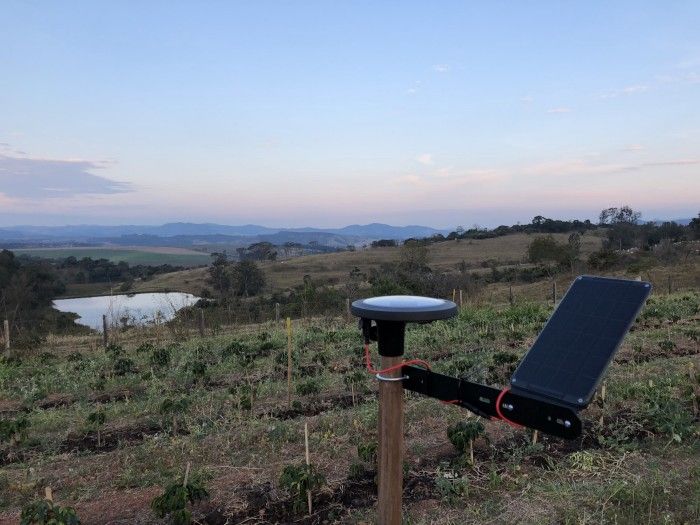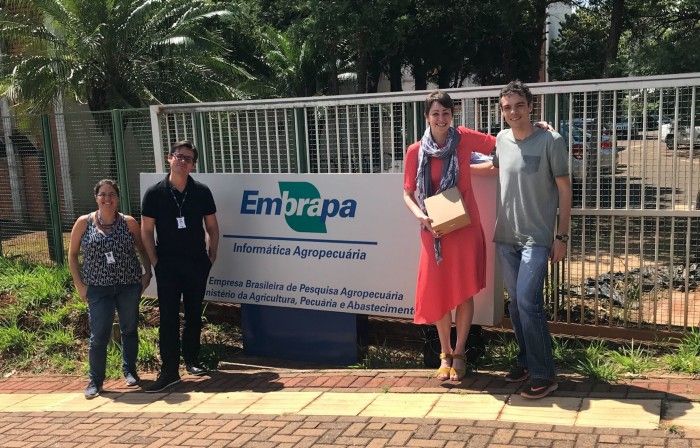- EN
- PT
Brazil Needs Better Weather Data to Feed the World
The Arable Mark tracking microclimate and plant data in a coffee field in São Paulo province, Brazil.
Brazil is the largest exporter of coffee, sugarcane, beef and crop-based ethanol biofuel, and the second largest producer of soybeans. Farming and agricultural products combine with food processing to comprise approximately 30% of the GDP. In 2017, Brazil’s agricultural sector grew by 13%, while the rest of the economy grew about one percent. Over the past thirty years, Brazil has seen a doubling in crop yields due to access to improved inputs, policies of export-led growth, reduced tax burdens and improved exchange rate, as well as an increased global demand for soy due to evolving class status and increased meat consumption. Global food demand is expected to increase anywhere between 59% to 98% by 2050, and we are dependent upon agricultural production in Brazil to close this gap. On a recent trip to Brazil, every grower we met consistently pointed to weather, crop protection, and labor as the key pain points within their operation. Weather is by far the greatest challenge, hampering any ability to build and carry out reliable management plans. Because of the tropical environment and double planting seasons, the challenges of timing herbicide, pesticide, and fungicide applications are even more complex in Brazil than anywhere else in the world. To continue to increase ag production, growers need accurate and actionable information at the seasonal timescale to make input purchasing decisions, as well as short-term forecasts to plan field operations, such as planting, spraying, and harvesting.
Accessing accurate weather information in Brazil is challenging. High fidelity numerical forecasting relies on gridded weather data sets (GWDs) generated from satellites and downscaled with ancillary data from meteorological stations, NEXRAD towers and weather balloons. Brazil lacks sufficient radio sounding, met stations, radars, and atmospheric profiling to effectively downscale GWDs. The tropical climate is characterized by small-scale, convective precipitation events caused by rapid surface heating and cloud formation. In Mato Grosso, more than 80% of the precipitation is from convective storm systems, which are notoriously difficult to predict. Unfortunately, most Brazilian farmers are left to rely on GWD-based weather products. They provide inaccurate measurements of precipitation, reference evapotranspiration, and seasonal water deficit. For growing degree day based phenological models, using GWDs typically results in errors of 3-7 days from field observed growth stages. When used to predict yield outcomes against meteorological networks, GWDs deviated from ground networks by more than 15 percent. GWDs may be fine for decisions such as whether to pack an umbrella, but without a ‘ground-truth’ weather network, they cannot be relied upon for livelihood-impacting decisions, such as harvesting dates, spray decisions, crop marketing, and insurance.
What if there were an easy way to get real-time, accurate and reliable data to growers in Brazil?
There are two consistent problems with publicly available weather networks: they are placed in public locations, often at a distance from where measurements would be consequential to grower decision-making, and they require maintenance and calibration to achieve adequate performance levels. These two issues create a mismatch between value and cost, rendering the network too expensive and the data irrelevant. This problem is not unique to Brazil. Now imagine if across Brazil’s 80M cultivated hectares we installed an intelligent network of devices that required minimal maintenance and no recalibration, measured all key elements relevant to crop growth, and connected anywhere regardless of cellular infrastructure. We believe that the technologies needed to make this system a reality are just now becoming available and open up new possibilities for solving some of the most pressing challenges in Brazilian agriculture. The total price tag for nationwide crop health analytics would amount to less than 0.3% of the credit banks lend out for agriculture alone in the country. The region of Mato Grosso could build both a spray recommendation network and yield forecasting system for $1.67 per hectare ($.67/acre), which we believe is a small fraction of the value that could be created for farmers.
Who wins?
While it may be obvious that this system directly benefits growers through delivering predictive analytics on weather and crop yields, a number of other industries also stand to gain from increased transparency. Brazilian farmers are heavily dependent on access to credit markets to fund farming operations. In Brazil, credit is highly subsidized, meaning banks take on a disproportionate amount of risk without insight into the management practices and localized weather patterns that impact output at the end of the season. During the 2017–18 harvest season, Brazilian banks lent out $45B to farmers, the greatest amount in history, with plans to further increase lending for the 2018–19 season (estimated at $51B). Access to rural credit is crucial for the Brazilian agro-industry to maintain its position as leading producer. At the same time, the insurance market in Brazil remains immature, especially when compared to the long-established, heavily subsidized US multi-peril crop insurance programs. In Brazil, parametric insurance, or drought coverage, is offered using CHIRPS datasets. Reducing basis risk to encourage participation is critical to driving profit maximizing decisions on the farm. With better microclimate and crop models, ag input companies can deliver environment-tailored products and genetics while providing more precise agronomic recommendations to growers based on field-specific conditions, and in return, they gain satisfied customers. Food and agribusiness gains insight into potential supply-side disruptions, and can optimize procurement decisions. Most importantly, due to Brazil’s outsize role, the global food system wins through field-level decision optimization and the improved quality, yield outcomes, and stability that continues to catalyze investment needed to meet our increasing food demand.
We launch initial pilots in Brazil starting in September, 2019 to improve weather monitoring and crop forecasting for agronomic decisions in tropical climates. If you are interested in learning more or working with us, please get in touch.

